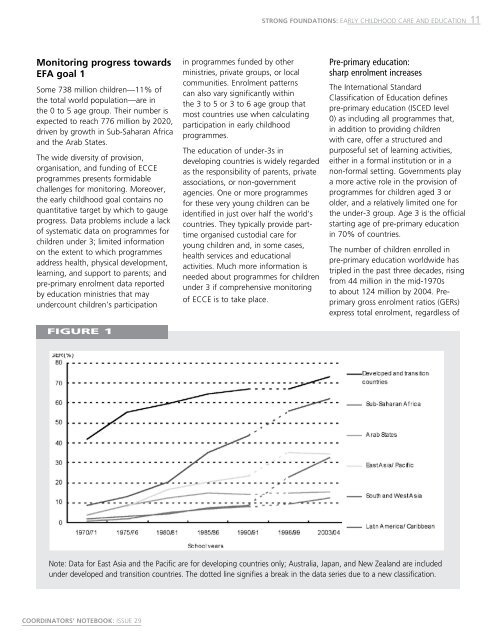A global call to action for early childhood
A global call to action for early childhood
A global call to action for early childhood
You also want an ePaper? Increase the reach of your titles
YUMPU automatically turns print PDFs into web optimized ePapers that Google loves.
Strong foundations: Early <strong>childhood</strong> care and education<br />
11<br />
Moni<strong>to</strong>ring progress <strong>to</strong>wards<br />
EFA goal 1<br />
Some 738 million children—11% of<br />
the <strong>to</strong>tal world population—are in<br />
the 0 <strong>to</strong> 5 age group. Their number is<br />
expected <strong>to</strong> reach 776 million by 2020,<br />
driven by growth in Sub-Saharan Africa<br />
and the Arab States.<br />
The wide diversity of provision,<br />
organisation, and funding of ECCE<br />
programmes presents <strong>for</strong>midable<br />
challenges <strong>for</strong> moni<strong>to</strong>ring. Moreover,<br />
the <strong>early</strong> <strong>childhood</strong> goal contains no<br />
quantitative target by which <strong>to</strong> gauge<br />
progress. Data problems include a lack<br />
of systematic data on programmes <strong>for</strong><br />
children under 3; limited in<strong>for</strong>mation<br />
on the extent <strong>to</strong> which programmes<br />
address health, physical development,<br />
learning, and support <strong>to</strong> parents; and<br />
pre-primary enrolment data reported<br />
by education ministries that may<br />
undercount children’s participation<br />
figure 1<br />
in programmes funded by other<br />
ministries, private groups, or local<br />
communities. Enrolment patterns<br />
can also vary significantly within<br />
the 3 <strong>to</strong> 5 or 3 <strong>to</strong> 6 age group that<br />
most countries use when calculating<br />
participation in <strong>early</strong> <strong>childhood</strong><br />
programmes.<br />
The education of under-3s in<br />
developing countries is widely regarded<br />
as the responsibility of parents, private<br />
associations, or non-government<br />
agencies. One or more programmes<br />
<strong>for</strong> these very young children can be<br />
identified in just over half the world’s<br />
countries. They typi<strong>call</strong>y provide parttime<br />
organised cus<strong>to</strong>dial care <strong>for</strong><br />
young children and, in some cases,<br />
health services and educational<br />
activities. Much more in<strong>for</strong>mation is<br />
needed about programmes <strong>for</strong> children<br />
under 3 if comprehensive moni<strong>to</strong>ring<br />
of ECCE is <strong>to</strong> take place.<br />
Pre-primary education:<br />
sharp enrolment increases<br />
The International Standard<br />
Classification of Education defines<br />
pre-primary education (ISCED level<br />
0) as including all programmes that,<br />
in addition <strong>to</strong> providing children<br />
with care, offer a structured and<br />
purposeful set of learning activities,<br />
either in a <strong>for</strong>mal institution or in a<br />
non-<strong>for</strong>mal setting. Governments play<br />
a more active role in the provision of<br />
programmes <strong>for</strong> children aged 3 or<br />
older, and a relatively limited one <strong>for</strong><br />
the under-3 group. Age 3 is the official<br />
starting age of pre-primary education<br />
in 70% of countries.<br />
The number of children enrolled in<br />
pre-primary education worldwide has<br />
tripled in the past three decades, rising<br />
from 44 million in the mid-1970s<br />
<strong>to</strong> about 124 million by 2004. Preprimary<br />
gross enrolment ratios (GERs)<br />
express <strong>to</strong>tal enrolment, regardless of<br />
Regional trends in pre-primary gross enrolment ratios<br />
Note: Data <strong>for</strong> East Asia and the Pacific are <strong>for</strong> developing countries only; Australia, Japan, and New Zealand are included<br />
under developed and transition countries. The dotted line signifies a break in the data series due <strong>to</strong> a new classification.<br />
COORDINATORS’ NOTEBOOK: ISSUE 29
















